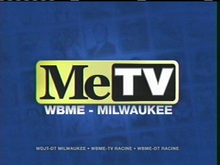Station identification
In Southeast Asia, idents are known as a montage in Thailand and the Malay world (except Indonesia, known as station ID, terminology shared with the Philippines), and as an interlude in Cambodia and Vietnam.In the present day, most broadcasters use a set of multiple identifiers built around a particular theme or branding element, often based on the channel's current overall look.Since the consolidation of the ITV network in the early 2000s, regional continuity announcements have generally disappeared, with STV being the only notable exceptions.[2][3] The Ley Federal de Telecomunicaciones y Radiodifusión[4] enacted in 2014 does not include a requirement for regular on-air station identification.However, many stations continue to air twice an hour their call letters (in Spanish) along with their city of license, as was required previously under Article 76 of the Ley Federal de Radio y Televisión.[5] The United States' Federal Communications Commission (FCC) enforces specific requirements for identification that must be followed by all terrestrial radio and television stations.On radio, the top-of-hour ID must contain the full, legal call sign (including any relevant suffixes, particularly "FM") as assigned by the FCC, followed immediately by the station's community of license.An example of a proper spoken radio station identification in the United States would be "WMAS-FM Enfield Springfield" or "WLAN-FM Lancaster".As no audio announcement of the call sign is necessary if the information appears on screen, often the identification is fulfilled by incorporating it into a short promo for a program the station airs (such as a syndicated or network program, or a preview of an upcoming newscast), the title sequence of the station's newscasts, or automatically cued as a digital on-screen graphic briefly displayed at the required time.We do not wish to impose requirements that could now be cost prohibitive for licensees of translator and LPTV stations, thereby discouraging their conversion to digital operation.Amateur radio requires the call sign to be stated at the end of a communication and every ten minutes during (some hams use countdown clocks to remind them to identify); modes such as packet radio and fast-scan television often have a provision for automatic identification, either including it as part of a digital data stream or overlaying it over an analog picture.In the case of the GMRS service, this is to be done by each station in a similar manner to the amateur practice, though the time limit is fifteen minutes.Family Radio Service and Multi-Use Radio Service have no station identification requirement, though groups of individual users have their own procedures, such as using license plates or informal callsigns (some groups within the Boy Scouts of America, for example, use the troop number followed by the scout's initials as a callsign).A radio station operating in DAB hybrid mode or extended hybrid mode shall identify its digital signal, including any free multicast audio programming streams, in a manner that appropriately alerts its audience to the fact that it is listening to a digital audio broadcast.Amateur television operators (and also, news channels in other countries) often use a lower third or bug containing their callsign in lieu of voice identification.
Station Identification (album)bumpernetworkscall signproduction logosMalay worldMedia Nusantara CitraTrans MediaTrans TVTrans7CNN Indonesiacontinuity announcerNederland 1Nederland 2Nederland 3Yorkshire TelevisionEmmerdaleScottish TelevisionTake the High RoadUpstairs, DownstairsLondon Weekend TelevisionCOVID-19 pandemic in the United KingdomFederal Communications Commissionterrestrial radiotelevisionsign oncallsigncity of licensepublic service announcementsbroadcast automationcommunity of licenseRochesterWMAS-FMEnfieldSpringfieldWLAN-FMLancasterpitch shiftedLists of television stations in the United StatesRacineWBME-TVsubchannelWDJT-TVvirtual channeltitle sequencedigital on-screen graphiccourt showdigital televisionsimulcastingdigital transitionDigital subchannelsAccuWeatherClass AMilwaukee PBSbrokered programmingelectronic program guidesmart TVMorse codePart 15community-based radio stationscarrier currentcall signsshortwaveAmateur radiopacket radioRepeatersCitizen's BandFamily Radio ServiceMulti-Use Radio ServiceBoy Scouts of AmericaHigh Speed Multimedia (HSMM)HD RadioWauwatosaMilwaukeePlainfieldIndianapolisWCBS-FMWISN HDWINS-FMSheboygannetwork affiliationCharters TowersCedunaWollongongQueenslandWIN TelevisionNine NetworkTeletextcharacter generatorAmateur televisionnews channelslower thirdHistory of BBC television identsClock identHistory of ITV television identsCBS logosNBC logosPBS logosAmerican Broadcasting Company logosMGM logosDomo-kunHato no kyujitsuList of ABS-CBN Corporation slogansList of GMA Network slogansAutomatic Transmitter Identification System (television)ABS-CBN CorporationBelfast TelegraphTwitterCornell Law SchoolAustralian Communications & Media Authority